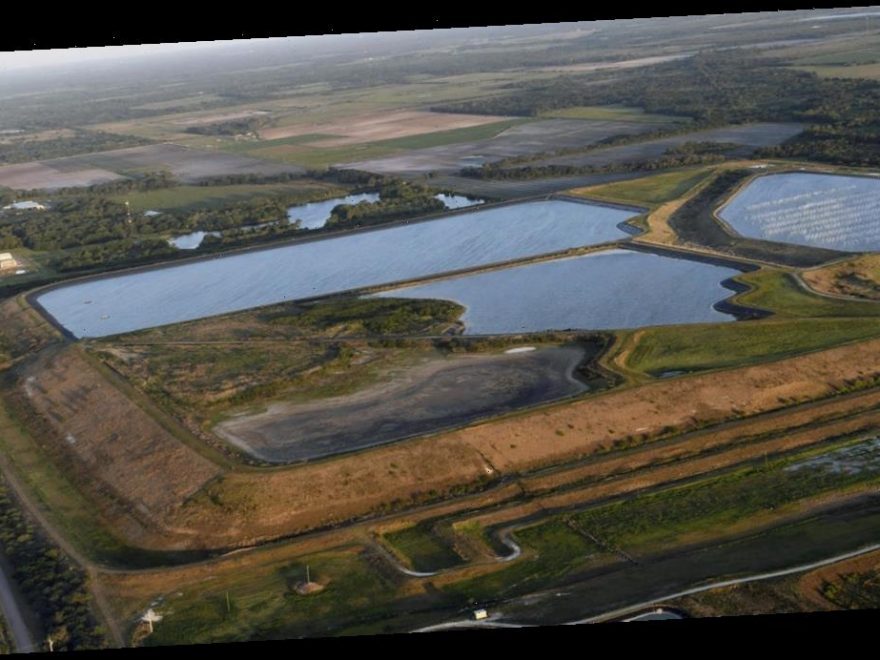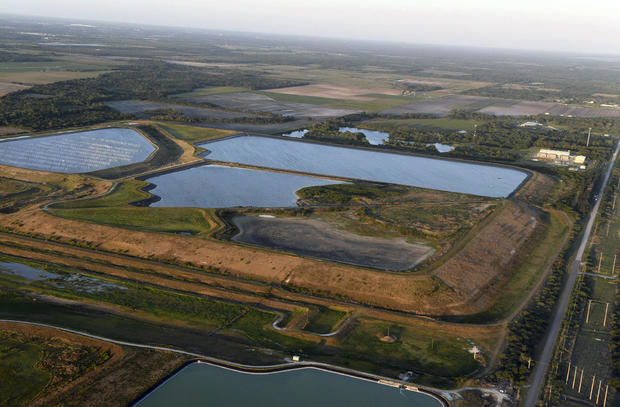Hundreds of residents in Manatee County, Florida, were ordered to evacuate their homes over Easter weekend as officials feared that a wastewater pond could collapse “at any time.” On Saturday, Florida Governor Ron DeSantis declared a state of emergency for the area.
County officials said the pond, located at the former Piney Point phosphate processing plant, had a “significant leak,” according to CBS affiliate WTSP-TV. The Manatee County Public Safety Department told people near the plant to evacuate due to an “imminent uncontrolled release of wastewater.”
“A portion of the containment wall at the leak site shifted laterally,” said Manatee Director of Public Safety Jake Saur, “signifying that structural collapse could occur at any time.”
Manatee County Public Safety Department initially sent out emergency evacuation notices on Friday for those who were within half a mile of Piney Point, and by 11 a.m. Saturday, evacuation orders were extended to people within one mile north of the reservoir’s stacks of phosphogypsum — a fertilizer waste product — and those within half a mile to the south of the site. Surrounding stretches of highway were also closed to traffic.
Mandatory evacuations were extended an additional half mile west and one mile southwest of the site on Saturday evening. Manatee County Public Safety Department said that 316 households are within the full evacuation area.
At a press conference Sunday morning, DeSantis said officials are pumping out 33 million gallons of water a day from the pond, and that the water “is not radioactive,” although another official added that the water is “not water we want to see leaving the site.” The primary concern, DeSantis said, is the nutrient makeup of the water, which contains metals. Reports on water samples should be available in the coming days.
“We’re hoping that we can just continue to get the water out in an efficient way to prevent a catastrophic event,” DeSantis said.
Officials said at the meeting that the greatest threat for the time being is flooding. Even after days of pumping water out of reservoir, there are still roughly 3,450 million gallons of wastewater that could suddenly be unleashed.
If the reservoir were to fully collapse, one model shows that the area could see a “20-foot wall of water” within minutes, acting Manatee County administrator Scott Hopes said.
Phosphogypsum is the “radioactive waste” left over from processing phosphate ore into a state that can be used for fertilizer, according to the Center for Biological Diversity.
“In addition to high concentrations of radioactive materials, phosphogypsum and processed wastewater can also contain carcinogens and heavy toxic metals,” the center said in a statement on Saturday. “For every ton of phosphoric acid produced, the fertilizer industry creates 5 tons of radioactive phosphogypsum waste, which is stored in mountainous stacks hundreds of acres wide and hundreds of feet tall.”
Manatee County Commissioner Vanessa Baugh said in a statement Saturday that the “public must heed that notice to avoid harm.”
The water that is currently being pumped out by officials to avoid a full collapse is a mix of sea water from a local dredge project, storm water and rain runoff. The water has not been treated.
“The water meets water quality standards for marine waters with the exception of pH, total phosphorus, total nitrogen and total ammonia nitrogen,” the state said in a statement. “It is slightly acidic, but not at a level that is expected to be a concern, nor is it expected to be toxic.”
Florida Commissioner of Agriculture Nikki Fried wrote a letter to DeSantis on Saturday urging an emergency session of the Florida Cabinet to discuss the situation. She wrote that the leaking water is “contaminated, radioactive wastewater,” and noted that this leak is not the property’s first.
“For more than 50 years, this Central Florida mining operation has caused numerous human health and environmental disasters and incidents,” Fried wrote. “There have been numerous, well-documented failures — which continue today — of the property’s reservoir liner, including leaks, poor welds, holes, cracks and weaknesses that existed prior to purchase by the current owner, HRK Holdings, and exacerbated since.”
I have requested that @GovRonDeSantis convene an emergency meeting of the Florida Cabinet for a briefing by @FLDEPNews Secretary @NoahValenstein on the imminent #PineyPoint disaster.
🚨 If you are in the area, follow directions from local officials and evacuate NOW if ordered. pic.twitter.com/3UUz4VikO5
On Sunday, Hopes corroborated that issues with the Piney Point facility have persisted for decades. While the governor on Sunday blamed the situation on HRK Holdings, the company that owns the site, and said it will be held accountable for the incident, Hopes indicated that the latest leak is the result of officials not acting on past failures.
“It could have been resolved two decades ago,” Hopes said. “What I’ve seen in the past four days from the governor’s office is that all agencies and entities are now committed to a permanent resolution.”
Meanwhile, the Florida National Guard deployed two CH-47 helicopters on Sunday to place two pumps at the site to lower the water level. The pumps should be running at full capacity by Monday morning, Hopes said at a Sunday afternoon press conference.
“The controlled release is working,” he said. “The breach release is traveling in the direction that we anticipated and planned for so we believe that probably by Tuesday we’re going to be in a much better position and the risk level will have decreased significantly with the governor’s assets.”
Two of our CH-47s spent today working w/ our partners in response to the Piney Point Reservoir leak. The helos conducted an overflight w/ @GovRonDeSantis & placed two pumps to help lower the water level enough to repair the leak. Follow @manateegov for more info. #FLNGAlwaysThere pic.twitter.com/b6mjsqoSfR
Authorities noted that Manatee County water is safe to drink and there is no threat to Lake Manatee, which is the primary source of drinking water. Well water was also not affected.
Officials describe lead up to latest incident
Video of a Manatee County Commissioners meeting provided insight into what happened prior to the leak. On Thursday afternoon, Jeff Barath, a representative for HRK Holdings, appeared emotionally distressed while briefing the Manatee County Commissioners about the situation.
“I’m very sorry,” he said. He told commissioners he had only slept a few hours that week because he was trying to fix the situation, and through tears, said he first noticed “increased conductivities within the site’s seepage collection system” 10 days prior on March 22. This system, he said, offers drainage around the gypsum stacks.
He said he immediately notified FDEP of his concerns.
“The water was changing around the seepage. We went into a very aggressive monitoring program,” he said, to find out where the seepage was coming from.
They discovered the south side of the stack system had “increased in conductivity” and that the acidity of the water, which is normally around a 4.6, had dropped to about a 3.5, which indicated an issue.
After a few days, the water chemistry had not improved and water flows were increasing from about 120 gallons a minute to more than 400 gallons per minute in less than 48 hours, Barath said. Last Saturday night, the flow rates increased to “rates that I could not even estimate to you,” he said.
Water was filling the stacks so quickly that the ground was starting to rise, Barath said. This “bulging” was temporarily stabilized but then extended hundreds of feet.
Barath submitted a report to the state on March 26, according to the state-run “Protecting Florida Together,” website, which was created by DeSantis to allow more transparency about state water issues.
“I was anticipating that the gypstack itself was destabilizing at a very rapid rate and recommended that we consider an emergency discharge,” he told commissioners. He said he feared that “overpressurizing” the system would result in “complete failure.”
“I’ve spent most of my days and nights constantly monitoring all aspects of this gypstack system and identifying failure points within it,” he said, noting that failure points were happening “constantly, I mean hourly.”
The Florida Department of Environmental Protection said that it ordered the company to “take immediate action” to prevent further leaks. On March 30, the department said that “pipes at the facility are repaired” and controlled discharges were initiated to prevent any pressure buildup.
However, based on Barath’s testimony at the meeting, the situation was far from over. He concluded his address by saying they were doing “everything possible to prevent a true catastrophe.”
On Friday, another leak was detected in the south containment area of the facility. Despite overnight work to attempt to stop this and other leaks, Manatee Director of Public Safety Jake Saur said on Saturday that the situation was “escalating.”
April Siese contributed to this report.
Source: Read Full Article

